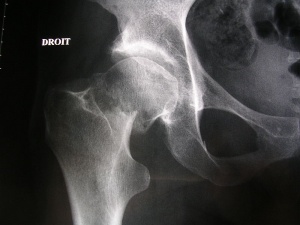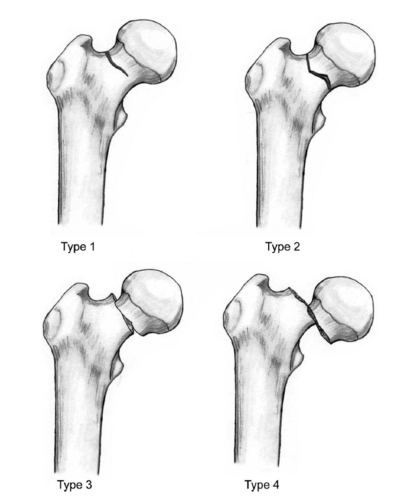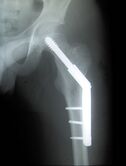Femoral Neck Fractures, Garden Classification: Difference between revisions
No edit summary |
No edit summary |
||
| Line 5: | Line 5: | ||
</div> | </div> | ||
== Introduction == | == Introduction == | ||
'''The Garden classification''' is the most commonly used for [[Femoral Neck Fractures|femoral neck fractures]]. | [[File:Neck of femur fracture (garden IV).jpeg|thumb|NOF fracture, Garden 4]] | ||
'''The Garden classification''' is the most commonly used for [[Femoral Neck Fractures|femoral neck fractures]]. It is simple and predicts the development of [[Avascular necrosis of the femoral head]]. Garden splits into four categories depending on the severity of the fracture and the degree of displacement. The Types being: | |||
# Type I is an incomplete fracture or valgus impacted [[fracture]]. | |||
# Type II is a complete fracture without displacement. | |||
# Type III is a complete fracture with partial displacement of fracture fragments. | |||
# Type IV is a complete fracture with total displacement of fracture fragments, allowing the femoral head to rotate back to its anatomical position within the acetabulum.<span class="reference" id="cite_ref-:5_6-1"></span><ref>Florschutz AV, Langford JR, Haidukewych GJ, Koval KJ. [https://journals.lww.com/jorthotrauma/Abstract/2015/03000/Femoral_Neck_Fractures__Current_Management.2.aspx Femoral neck fractures: current management.] Journal of orthopaedic trauma. 2015 Mar 1;29(3):121-9.</ref> | |||
[[File:Fig5.png|center|thumb|499x499px|Garden classification for femoral neck fractures]] | [[File:Fig5.png|center|thumb|499x499px|Garden classification for femoral neck fractures]] | ||
== Surgical Treatment == | |||
[[File:DHS.jpg|thumb|166x166px|DHS]] | |||
In general: | |||
# Garden stage I and II are stable fractures and can be treated with internal fixation (head-preservation) eg [[Dynamic Hip Screw - DHS|Dynamic hip screw DHS]] | |||
# Garden stage III and IV are unstable fractures and hence treated with hemi or [[Total Hip Replacement|total hip replacement]].<ref>Radiopedia Classification Garden Available: https://radiopaedia.org/articles/garden-classification-of-hip-fractures?lang=gb<nowiki/>(accessed 13.12.2022)</ref> | |||
== References == | == References == | ||
<references /> | <references /> | ||
Revision as of 06:56, 13 December 2022
Original Editor - Lucinda hampton
Top Contributors - Lucinda hampton and Kim Jackson
Introduction[edit | edit source]
The Garden classification is the most commonly used for femoral neck fractures. It is simple and predicts the development of Avascular necrosis of the femoral head. Garden splits into four categories depending on the severity of the fracture and the degree of displacement. The Types being:
- Type I is an incomplete fracture or valgus impacted fracture.
- Type II is a complete fracture without displacement.
- Type III is a complete fracture with partial displacement of fracture fragments.
- Type IV is a complete fracture with total displacement of fracture fragments, allowing the femoral head to rotate back to its anatomical position within the acetabulum.[1]
Surgical Treatment[edit | edit source]
In general:
- Garden stage I and II are stable fractures and can be treated with internal fixation (head-preservation) eg Dynamic hip screw DHS
- Garden stage III and IV are unstable fractures and hence treated with hemi or total hip replacement.[2]
References[edit | edit source]
- ↑ Florschutz AV, Langford JR, Haidukewych GJ, Koval KJ. Femoral neck fractures: current management. Journal of orthopaedic trauma. 2015 Mar 1;29(3):121-9.
- ↑ Radiopedia Classification Garden Available: https://radiopaedia.org/articles/garden-classification-of-hip-fractures?lang=gb(accessed 13.12.2022)









